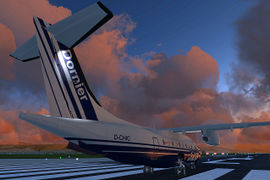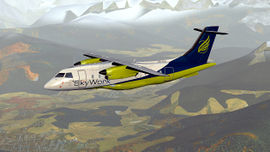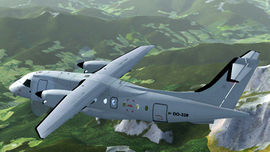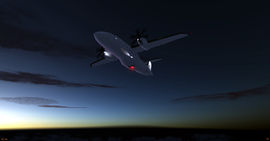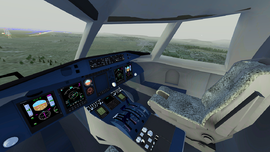Dornier 328: Difference between revisions
(Dornier 328- finally back! Delete deletion notification - made some major progress on the fdm!) |
(Copyediting; Moving around a few paragraphs; Moving up the images) |
||
| Line 1: | Line 1: | ||
{{infobox Aircraft | {{infobox Aircraft | ||
|image = Dornier328.2.jpg | |image = Dornier328.2.jpg | ||
| Line 16: | Line 15: | ||
}} | }} | ||
[[File:Dornier 328 First Prototype.jpg|thumb|270px |First prototype of Dornier 328 in its House colors- model before prop had been textured but I do like the sky in the background and the light effect on the tail]] | |||
[[File:Dornier328.jpg|thumb|270px |Dornier 328 TurboProp exterior model in Skywork Airlines colors, current state at 08/20/2013]] | |||
[[File:Dornier 328 above the autrian alps.jpg|thumb||270px |upper side of the Dornier 328, showing wing structure]] | |||
[[File:DO328 Multiple Lightmaps.jpg|thumb|270px|Testing the multiple lightmap feature. Here showing the logo lights at the tail, and the de-ice lights in FlightGear. Effects of Beacon and Landinglights still missing]] | |||
[[File:DO328LatestPanelDev.png|thumb|270px |[11/19/2013] flightdeck progress- PFD and MFD working; working throttle quadrant, nearly working autoflight panel- still a lot to do]] | |||
The '''Dornier 328''' [[aircraft]] is a shortrange commuter, developed and built by [[Dornier|Dornier]]. It was the last flying aircraft made by Dornier, and the last airliner completely developed and built in Germany. | |||
The FlightGear model is currently in development, simulating the Dornier 328-110 with ground spoilers with and without APU. | |||
Special Thanks to the user Groucho from the FlightGear forums, who made it possible for me look into the flight manual! Also thanks to the author of the 747-200 which showed mo how to deal with the FDM problem. | |||
== | == NOTAM == | ||
# Finally back! WIP 07/07/2015: new JSBSim-FDM witch finally matches [[Aircraft speed#V speeds|V speeds]] (V<sub>R</sub>, V<sub>Ref</sub>, ...) together with pitch attitudes and AOA - matches POH pretty well! Unfortunately the rating system doesn't reflect this. | |||
# Landing estimated late summer 2015 | |||
# Please regard FlightGear's etiquette: contact the authors first you help and contribute - this helps to prevent chaos in developing, since the efforts can be coordinated. | |||
__TOC__ | |||
== History == | |||
The development has been started back in the 1980s as successor for the Dornier 228. Dornier found that there was a market for a 33-passenger aircraft, so they created an aircraft with a complete round fuselage and the TNT-wing (Tragflügel neuer Technologie = Wing of New Technology) of the Dornier 228. | |||
Development started December 1988; its maiden flight was on December 6, 1991 and in October 1993 was certified. | |||
The aircraft had been developed for high climb rate and high speed, but short landing which was possible due the wing and the new developed propeller. As non-typical for this class of aircraft the flight deck has been fitted with 5 Displays from the Honeywell Primus 2000 avionic. The cabin was very comfortable for its class, as it was wide and round, and there was an active electronic noise suppression, giving a jet-like feeling. | |||
In the 90s turboprop aircraft were unpopular, as flight companies preferred smaller jets. So Fairchild-Dornier developed the Dornier 328 JET, a jet driven version of the Dornier 328. | |||
There had been larger versions of this aircraft planned: Dornier 428 and 528, stretched versions of the Dornier 328, but these were never built. | |||
When Fairchild-Dornier went bankrupt, the production of the Dornier 328 had been stopped in 2005, only 217 aircraft (prop and jet version) had been built, plus 3 prototypes. | |||
=== Variants === | |||
There are 4 Turboprop- variants available, and 3 Jet variants: | |||
* Dornier 328-100 (basic version, 33 passengers, Pratt & Whitney Canada PW119) | |||
* Dornier 328-110 (increased MTOW by 350kg, increased range), Pratt & Whitney Canada PW119B) | |||
* Dornier 328-120 (special short range equipment) | |||
* Dornier 328-130 (higher speed, improved rudder, Pratt & Whitney Canada PW119C) | |||
Ground spoilers and APU were optional on all turboprop variants | |||
* Dornier 328-300/ 328JET (jet driven version) | |||
* Dornier 328 Envoy 3 (Business Jet version) | |||
* Dornier 328DBJ (Replacement of the Envoy 3 with a larger cabin) | |||
== Development notes == | |||
=== Completed already === | === Completed already === | ||
JSBSim | JSBSim FDM is currently in re-work again. | ||
Data used for the FDM: | |||
<ref>datas like wing incidence from the Original Flight Manual Dornier 328-100</ref> | <ref>datas like wing incidence from the Original Flight Manual Dornier 328-100</ref> | ||
| Line 73: | Line 71: | ||
<ref>{{cite web |url=http://www.flashcardmachine.com/dornier.html | title= Real life procedures |publisher=flashcardgame }}</ref> | <ref>{{cite web |url=http://www.flashcardmachine.com/dornier.html | title= Real life procedures |publisher=flashcardgame }}</ref> | ||
====Exterior==== | ==== Exterior ==== | ||
*''' [11/19/2013]:''' | *''' [11/19/2013]:''' Textured and animated props, improvements to landing gear, small updates to liveries | ||
====Interior==== | ==== Interior ==== | ||
*''' [11/19/2013]:''' | *''' [11/19/2013]:''' Flightdeck progress- PFD and MFD working; working throttle quadrant, nearly working autoflight panel | ||
==== | ==== Autoflight ==== | ||
*''' [11/19/2013]:''' | *''' [11/19/2013]:''' Added autoflight system from Syd's Citation X | ||
==To- | == To-do list == | ||
==== | === Near term tasks === | ||
==== FDM ==== | |||
# | # Tuning engine and prop files so it will match the published testflight datas for climb rates and speeds. | ||
# | # Correct groundspoiler logic | ||
# | # Simulating roll spoiler | ||
# | # Reduce braking force of landing gear to match real landing distances | ||
# | # Simulate latch of throttle | ||
# | # Tune fuel consumption | ||
==== Finishing the flightdeck ==== | |||
# | # Working autoflight panel | ||
# Overhead Panel with fully 3d models knobs, switches, warning lights | # Overhead Panel with fully 3d models knobs, switches, warning lights | ||
# Center Pedestal | # Center Pedestal | ||
# EICAS page(s) | # EICAS page(s) → canvas?? | ||
# | # Adding small details (pencils, placards...) | ||
==== | ==== Systems ==== | ||
# | # Autoflight: More tuning, change systems to act like real thing | ||
==== | ==== 3D-model ==== | ||
# Missing animation | |||
# Realistic wing flex | |||
# Add lights | |||
# Optimize for Rembrandt (No-shadow tags, lights) | |||
# Realistic sounds | |||
# Dummy cabin so you can't look through the fuselage anymore | |||
==== Dornier 328-300/JET ==== | |||
# Creating the 328JET fdm | |||
# Modifying the exterior model to the Jet version | |||
# Modifiying the flightdeck to jet version (Overhead panel, center pedestal, Primus 2000 EICAS) | |||
=== Mid term tasks === | |||
# Add cabin | |||
=== Long term tasks === | |||
All that is left | |||
{{Appendix}} | {{Appendix}} | ||
Revision as of 12:46, 14 July 2015
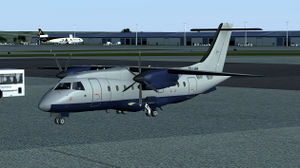 | |
| Type | Airliner |
|---|---|
| Author(s) |
|
| FDM | YASim |
| --aircraft= | do328 |
| Status | Beta |
| FDM |
|
| Systems |
|
| Cockpit |
|
| Model |
|
| Download |
|
The Dornier 328 aircraft is a shortrange commuter, developed and built by Dornier. It was the last flying aircraft made by Dornier, and the last airliner completely developed and built in Germany.
The FlightGear model is currently in development, simulating the Dornier 328-110 with ground spoilers with and without APU.
Special Thanks to the user Groucho from the FlightGear forums, who made it possible for me look into the flight manual! Also thanks to the author of the 747-200 which showed mo how to deal with the FDM problem.
NOTAM
- Finally back! WIP 07/07/2015: new JSBSim-FDM witch finally matches V speeds (VR, VRef, ...) together with pitch attitudes and AOA - matches POH pretty well! Unfortunately the rating system doesn't reflect this.
- Landing estimated late summer 2015
- Please regard FlightGear's etiquette: contact the authors first you help and contribute - this helps to prevent chaos in developing, since the efforts can be coordinated.
History
The development has been started back in the 1980s as successor for the Dornier 228. Dornier found that there was a market for a 33-passenger aircraft, so they created an aircraft with a complete round fuselage and the TNT-wing (Tragflügel neuer Technologie = Wing of New Technology) of the Dornier 228.
Development started December 1988; its maiden flight was on December 6, 1991 and in October 1993 was certified.
The aircraft had been developed for high climb rate and high speed, but short landing which was possible due the wing and the new developed propeller. As non-typical for this class of aircraft the flight deck has been fitted with 5 Displays from the Honeywell Primus 2000 avionic. The cabin was very comfortable for its class, as it was wide and round, and there was an active electronic noise suppression, giving a jet-like feeling.
In the 90s turboprop aircraft were unpopular, as flight companies preferred smaller jets. So Fairchild-Dornier developed the Dornier 328 JET, a jet driven version of the Dornier 328. There had been larger versions of this aircraft planned: Dornier 428 and 528, stretched versions of the Dornier 328, but these were never built.
When Fairchild-Dornier went bankrupt, the production of the Dornier 328 had been stopped in 2005, only 217 aircraft (prop and jet version) had been built, plus 3 prototypes.
Variants
There are 4 Turboprop- variants available, and 3 Jet variants:
- Dornier 328-100 (basic version, 33 passengers, Pratt & Whitney Canada PW119)
- Dornier 328-110 (increased MTOW by 350kg, increased range), Pratt & Whitney Canada PW119B)
- Dornier 328-120 (special short range equipment)
- Dornier 328-130 (higher speed, improved rudder, Pratt & Whitney Canada PW119C)
Ground spoilers and APU were optional on all turboprop variants
- Dornier 328-300/ 328JET (jet driven version)
- Dornier 328 Envoy 3 (Business Jet version)
- Dornier 328DBJ (Replacement of the Envoy 3 with a larger cabin)
Development notes
Completed already
JSBSim FDM is currently in re-work again.
Data used for the FDM:
[1] [2] [3] [4] [5] [6] [7] [8] [9] [10]
Exterior
- [11/19/2013]: Textured and animated props, improvements to landing gear, small updates to liveries
Interior
- [11/19/2013]: Flightdeck progress- PFD and MFD working; working throttle quadrant, nearly working autoflight panel
Autoflight
- [11/19/2013]: Added autoflight system from Syd's Citation X
To-do list
Near term tasks
FDM
- Tuning engine and prop files so it will match the published testflight datas for climb rates and speeds.
- Correct groundspoiler logic
- Simulating roll spoiler
- Reduce braking force of landing gear to match real landing distances
- Simulate latch of throttle
- Tune fuel consumption
Finishing the flightdeck
- Working autoflight panel
- Overhead Panel with fully 3d models knobs, switches, warning lights
- Center Pedestal
- EICAS page(s) → canvas??
- Adding small details (pencils, placards...)
Systems
- Autoflight: More tuning, change systems to act like real thing
3D-model
- Missing animation
- Realistic wing flex
- Add lights
- Optimize for Rembrandt (No-shadow tags, lights)
- Realistic sounds
- Dummy cabin so you can't look through the fuselage anymore
Dornier 328-300/JET
- Creating the 328JET fdm
- Modifying the exterior model to the Jet version
- Modifiying the flightdeck to jet version (Overhead panel, center pedestal, Primus 2000 EICAS)
Mid term tasks
- Add cabin
Long term tasks
All that is left
References
|
| ||||||||
